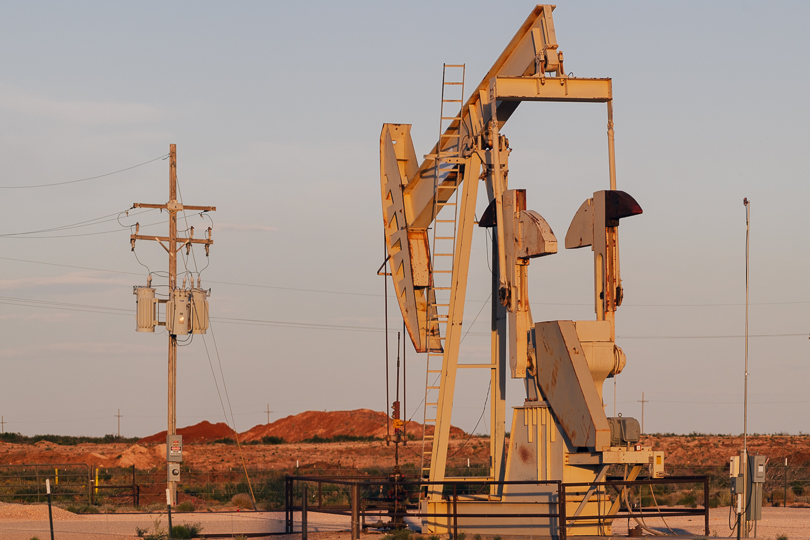On Wednesday, President Biden signed an executive order directing his Department of Interior to hit pause on entering new leases for oil and gas drilling on federal lands, the latest in a string of climate-related directives aimed at cutting greenhouse gas emissions.
On the campaign trail, then-candidate Joe Biden proposed a ban on new leases on public lands, a pledge the Trump campaign falsely claimed would “end fracking.” After Biden’s victory, a coalition of nearly 600 organizations from western states wrote a letter in December to the president-elect, urging him to follow through on his promise. The executive order begins that process.
About 25 percent of U.S. fossil fuel production came from federal lands over the past decade. Perhaps unsurprisingly, federal lands account for roughly 24 percent of U.S. greenhouse gas emissions, stemming from the production of oil, gas, and coal, along with the methane released during the extraction process, and the combustion of those fuels, according to the U.S. Geological Survey.
A big slice of that comes from coal, an industry that has been in decline for years. But drilling for oil and gas in the U.S. has increased dramatically in recent years, thanks in large part to fracking. While the oil industry quickly applauded the Biden administration for rejoining the Paris Climate Agreement, it was incensed that he would halt new drilling leases on federal lands.
Big Oil’s Biden-era PR strategy:
1) Act like you’re part of the solution by supporting “frameworks” like Paris and long term targets like 2050
2) Fight meaningful action — like rejecting KXL and ending drilling on public lands — by repeating lies about jobs and the economy
— Jamie Henn (@jamieclimate) January 25, 2021
When it comes to fracking on public lands, New Mexico’s portion of the Permian basin is ground zero. Much of the drilling in other shale regions, including Texas, Oklahoma, Colorado, and North Dakota, occurs on state or private land, and, as a result, won’t be impacted by the new policy. But New Mexico is home to a large drilling footprint on federal land, and roughly a quarter of the state’s tax revenue comes from oil and gas.
A Backlog of Leases
Various industry groups immediately sprang into action this week with the news that the Biden administration was gearing up to halt new leases. The U.S. Chamber of Commerce’s Global Energy Institute and the American Petroleum Institute, along with state chambers of commerce in New Mexico and Louisiana, hosted impromptu press calls for journalists on both Tuesday and Wednesday decrying the new policy.
The New Mexico Oil & Gas Association said that restricting drilling “risks the loss of more than 60,000 jobs and $800 million” in tax revenue for the state. The American Petroleum Institute (API) went further, saying a ban on new leases risks “hundreds of thousands of jobs and billions in government revenue.”
Restricting this oil and gas activity on New Mexico’s federal lands risks the loss of more than 60,000 jobs and $800 million in support for our public schools, first responders, and healthcare services. #NMPol #NMLeg
— New Mexico Oil & Gas (@NMOilAndGas) January 25, 2021
The oil and gas industry only directly employs a little over 160,000 people, according to the U.S. Labor Department.
API is claiming that more people would lose their jobs than the industry actually employs. Even accounting for ripple effects on related industries, it is a staggering claim.
But it’s “standard bullshit fear mongering,” Erik Schlenker-Goodrich, executive director of the Western Environmental Law Center, told DeSmog in an email. “Industry still has a surplus of just under 500,000 acres of federal public lands leases they have not yet developed, 31,000+ existing federal public lands oil & gas wells, and a stockpile of ~5,000 approved-but-unused federal public lands drilling permits.”
Because of the huge backlog of leases and permits, the pace of drilling won’t be significantly impacted as Biden’s moratorium only applies to new leases. In fact, the industry trade press has reported on the stockpiling of permits over much of 2020, as drillers hedged their bets heading into the presidential election.
Such a pause “would likely have a little immediate impact on nationwide oil and gas production figures” because of a shift in drilling from federal to state and private land, research firm Rystad Energy said in January 2020.
“A majority of significant Delaware New Mexico operators can maintain activity levels at the current pace (average of 2018-2019) for more than 20 years,” Artem Abramov, Head of Shale Research at Rystad Energy said in a statement at the time, referring to the Permian’s Delaware basin. If federal land is cut off, their backlog of leases would still last them more than a decade. “Needless to say, most of these companies have equally commercial opportunities on the Texas side of the Delaware basin, where federal acreage is practically non-existent.”
That assessment was from a year ago. Rystad issued an updated statement on January 25 in response to news of Biden’s imminent policy. “Most operators can maintain Tier 1 activity at the current pace in Delaware New Mexico for more than 10 years even without any new federal acreage permits,” Rystad’s Abramov said on Monday.
Industry Indifference?
Even some of the oil companies themselves are not too concerned. Devon Energy is one of the companies with the most exposure to federal lands. “We have always been very confident that we will continue to develop and drill on federal acreage,” David Hager, executive chairman of Devon Energy, told Reuters. Devon has enough permits to last around four years, he said.
EOG Resources, another big Permian driller, has a similar estimate. “When it comes to access to federal lands, that’s one of the things we’re not really worried about in our business. We have a lot of potential outside of federal land, too,” EOG’s chief operating officer, Billy Helms said at a 2020 investor conference.
.@Pearce4NM: Because of the federal leasing ban “I think we’re going to see companies choosing not to invest in New Mexico.”@APBusiness https://t.co/e8U1CKCPwL
— American Petroleum Institute (@APIenergy) January 26, 2021
New Mexico is already suffering budgetary pain from the pandemic-related decline in oil and gas markets. But the oil industry’s decline is structural, not cyclical, as the world shifts to cleaner forms of energy. As a result, New Mexico’s budgetary problems “cannot be dismissed as a temporary phenomenon,” analysts Tom Sanzillo and Suzanne Mattei at the Institute for Energy Economics and Financial Analysis (IEEFA) wrote in an October report. Slumping tax revenues in 2020 “serve as a harsh warning of fiscal stresses to come if the state’s heavy dependence on oil and gas revenues remains unchanged.”
At the same time, frontline communities living near drilling operations view the pause as an important first step in reducing the impacts on their lands and people. The Trump administration went to great lengths to expand drilling in the Greater Chaco Region in northwestern New Mexico.
“Local Navajo communities, through little or no ‘meaningful consultation,’ have consistently borne too much of the environmental and social impacts from federal oil and gas leasing,” Daniel Tso, Navajo Nation Council delegate, said in a statement. “As a result, Navajo Nation communities in northwestern New Mexico have suffered increased coronavirus morbidity, a methane cloud visible from space, and some of the worst air quality in the U.S. There has to be a balance point: people over money.”
The Biden administration’s new moratorium was well-received. “I welcome an end to federal fossil fuel leasing and the necessary transitions to more sustainable economies for the Navajo Nation,” Tso said.
Main image: A pump jack sits idle on Bureau of Land Management land in Eddy County, New Mexico. May 27, 2020. Credit: ©2020 Justin Hamel
Subscribe to our newsletter
Stay up to date with DeSmog news and alerts







